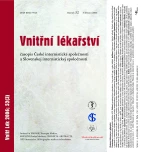Hypertension in pregnancy
Authors:
R. Cífková
Authors‘ workplace:
Pracoviště preventivní kardiologie IKEM, Praha, přednostka doc. MUDr. Renata Cífková, CSc.
Published in:
Vnitř Lék 2006; 52(3): 263-270
Category:
Review
Overview
Hypertension in pregnancy is one of the main causes of maternal, fetal and newborn morbidity and mortality in civilised countries. Current recommendations of the European Society for Hypertension prefer definition of hypertension in pregnancy based on absolute values of blood pressure, i.e. systolic blood pressure ≥ 140 mm Hg or diastolic blood pressure ≥ 90 mm Hg. The most important task of classification of hypertension in pregnancy is to distinguish whether hypertension comes before pregnancy (the so called pre-existing hypertension) or whether it is a pregnancy-induced condition (the so called gestational hypertension). Pre-existing hypertension is diagnosed either before pregnancy or within the first 20 weeks of pregnancy. Gestational hypertension is characterised with poor blood circulation in many body organs, higher value of blood pressure usually being just one of the characteristic features. Non-pharmacological treatment of hypertension must be considered in pregnant women with systolic blood pressure 140–150 mm Hg or diastolic blood pressure 90–99 mm Hg. Salt restriction is not recommended, as well as weight reduction in obese women. Systolic blood pressure ≥ 170 mm Hg or diastolic blood pressure ≥ 110 mm Hg in pregnant women must be considered serious condition necessitating hospitalisation. Pharmacological therapy should include labetalol i.v. or metyldopa or nifedipin administered orally. Intravenous administration of dihydralazine is no longer a therapy of choice, for its use is connected with increased occurrence of adverse effects. The threshold values for commencement of anti-hypertension therapy are systolic blood pressure 140 mm Hg or diastolic blood pressure 90 mm Hg in females with gestational hypertension without proteinuria or with pre-existing hypertension before commencement of 28th week of pregnancy. Drug administration to reduce hypertension is instituted after reaching the same threshold values in females with gestational hypertension and proteinuria or after occurrence of the symptoms any time during pregnancy, with the same threshold values of blood pressure in the case of pre-existing hypertension at the presence of accompanying diseases or organ malfunction and further in the case of pre-existing hypertension and gestational hypertension. In other cases drug treatment of hypertension is recommended at systolic blood pressure values of 150 mm Hg or diastolic blood pressure values of 95 mm Hg. Unless serious hypertension is involved, the drugs of choice include metyldope, labetalol, calcium channel blockers and betablockers. Calcium channel blockers are considered safe, unless administered concurrently with magnesium sulphate (risk of hypotension in the case of potential synergism). ACE inhibitors and angiotensine blockers II (AT1-blockers) are contraindicated in pregnancy. Treatment with diuretics is not substantiated, unless oliguria is present. I.v. magnesium sulphate is recommended for prevention of eclampsia and spasm treatment.
Key words:
pre-existing hypertension – gestational hypertension – non-pharmacological treatment of hypertension – metyldopa – labetalol – calcium channel blockers – magnesium sulphate
Sources
1. Garovic VD. Hypertension in pregnancy: Diagnosis and treatment. Mayo Clin Procedings 2000; 75 : 1071-1076.
2. National High Blood Pressure Education Program Working Group Report on High Blood Pressure in Pregnancy. Report of the National High Blood Pressure Education Program Working Group on High Blood Pressure in Pregnancy. Am J Obstet Gynecol 2000; 183 (suppl): S1-S22.
3. Paller MS. Hypertension in pregnancy. J Am Soc Nephrol 1998; 9 : 314-320.
4. Guidelines Committee. 2003 European Society of Hypertension - European Society of Cardiology guidelines for management of arterial hypertension. J Hypertens 2003; 21 : 1011-1053.
5. Higgins JR, de Swiet M. Blood pressure measurement and classification in pregnancy. Lancet 2001; 357 : 131-135.
6. Helewa ME, Burrows RF, Smith J et al. Report of the Canadian Hypertension Society Consensus Conference: 1. Definitions, evaluation and classification of hypertensive disorders in pregnancy. Can Med Assoc J 1997; 157 : 715-725.
7. Levine RJ, Ewell MG, Hauth JC et al. Should the definition of preeclampsia include a rise in diastolic blood pressure of ≥ 15 mm Hg to a level < 90 mm Hg in association with proteinuria? Am J Obstet Gynecol 2000; 183 : 787-792.
8. López-Jaramillo P, García RG, López M. Preventing pregnancy-induced hypertension: are there regional differences for this global problem? J Hypertens 2005; 23 : 1121-1129.
9. Kaplan NM. Clinical hypertension. 7th ed. Philadelphia: Williams and Wilkins 1998.
10. Moutquin JM, Garner PR, Burrows RF et al. Report of the Canadian Hypertension Society Consensus Conference: 2. Nonpharmacologic management and prevention of hypertensive disorders in pregnancy. Can Med Assoc J 1997; 157 : 907-919.
11. Sibai BM. Treatment of hypertension in pregnant women. N Engl J Med 1996; 335 : 257-265.
12. Magee LA, Ornstein P, von Dadelszen P. Fortnighly review. Management of hypertension in pregnancy. BMJ 1999; 318 : 1322-1326.
13. CLASP (Collaborative Low-dose Aspirin Study in Pregnancy) Collaborative Group. CLASP: a randomized trials of low dose aspirin for the prevention and treatment of pre-eclampsia among 9364 pregnant women. Lancet 1994; 343 : 619-629.
14. Magee LA, Cham Ch, Waterman EJ et al. Hydralazin for treatment of severe hypertension in pregnancy: meta-analysis. BMJ 2003; 327 : 955-960.
15. Seely EW. Hypertension in pregnancy: a potential window into long-term cardiovascular risk of women. Clin Endo Metab 1999; 84 : 1858-1861.
Labels
Diabetology Endocrinology Internal medicineArticle was published in
Internal Medicine

2006 Issue 3
Most read in this issue
- Effect of administration of Escherichia coli Nissle (Mutaflor) on intestinal colonisation, endo-toxemia, liver function and minimal hepatic encephalopathy in patients with liver cirrhosis
- Extension of QT interval as a consequence of risk factor accumulation – case study
- Immunoglobulin A and renal diseases
- Glibenclamide site of in insuline: a new chance for MODY 3 type diabetes patients: case report
